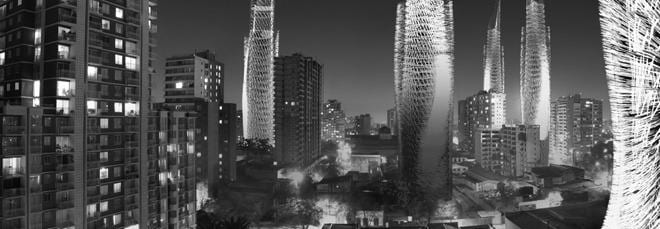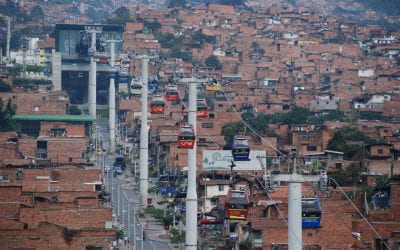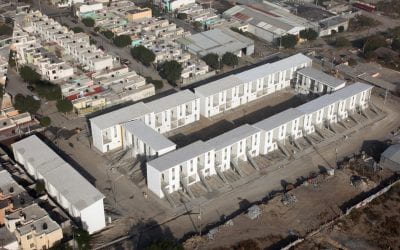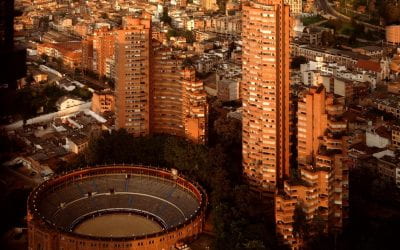The (Not Yet) Dialogue Project
A Deferred Conversation on Post-Unsustainability with Mark Jarzombek
So I have another sip of my coffee while looking out and enjoying the Chilean view. From here the city movement below seems to be in slow motion. The view is kind of foggy, not very crisp, but I still recognize the silhouette of Santiago’s skyline, the towers downtown, the San Cristóbal hill in the back, the Andes on the other side of the room. All delineated against a foggy orange-tinted sunset sky. The light inside the room is warm; the orange hue is slowly turning pink and bleeds all over the space. The coffee mug in my hand is still warm and as everybody seems to have left, it is quiet in here now. But I know this sensation is only temporary; outside it is very noisy, probably very hot too. As I look out I can almost feel the warm and sticky gusts blasting through the city. I turn my chair towards the view and sit with my coffee, remembering that conversation I had some years ago with Mark Jarzombek. I was still living in Boston and it was a time when, I remember now, the discussion about buildings and the environment was a hot, sometimes overrated, never-ending debate everywhere. It was by the end of the decade I think, maybe 2010, that the term sustainable and its variations had flooded every cultural, economic and technical discourse.
Sergio Araya: (…)well, Mark, you see, one of the biggest conflicts I have with sustainability is that you don’t know anymore, if we actually ever did, what we are talking about. It is such a ubiquitous word and it is applied in so many different contexts with so many different connotations underlying so many diverse purposes, that it is hard not to use it, but on the other hand it is even harder to actually mean anything when using it. Are we talking about economical sustainability? Or social sustainability? Or actually environmental sustainability? And then what does it mean and what does it implies in the context of architecture? Somehow among architects the question has become a technical and normative topic.
Mark Jarzombek: The architect still has the capacity to navigate culturally, relatively freely, between the industry, business, sciences, the arts and so forth… and it’s one of the few professions where that is understood.
S.A. Yes, but then even after entering any of these dimensions of sustainability, the architect still embodies, carries within, a specific way of looking at things, that is, its capacity to interrogate a situation and reformulate it. Architecture often borrows from other fields in order to reshape its own discourse and practice, but in this case, how much of its inquisitive and critical attitude is transformed by the powers and forces in action on these dimensions of sustainability? I suspect that somehow the urgency and global character of the sustainability challenge has prevented a critical and inquisitive approach from architecture. Actually sustainability has affected the architectural practice more than what architecture has helped shaped the idea of sustainability. So far.
M.J. Today, after 10 years or so, sustainability has become such a hot button topic that the architects have sort of focused on precise answers—we can solve it this way, we can do it better this way—and I think this is not that good. This is somewhat dangerous because then we become problem solvers, and we should be question makers, we should ask what are the questions first.
S.A. Of course, I agree with you on that. I remember Stan Anderson’s statement about architects being problem-worriers and not problem-solvers. Now are those universal questions or local questions? Are these questions the same in North and South America for example? I can tell you that although the dominant perspectives on this have been drawn by political and economical forces in the U.S. and Europe, the growing awareness coming from the developing world has different takes on the subject. Now, how can then the normative, recommendation and certification systems being currently implemented globally actually address these questions and localities? Isn’t this faith on…commercially available, standardized answers counterproductive in this sense? Which sustainability challenge is this actually addressing? To me this is much more about guaranteeing extended resource exploitation and globalization of industry standards with an economic purpose, than it actually is about civilization and nature and the changes they face.
M.J. 1985 is the day, year, that the UNESCO signed some project saying that we are living in an unsustainable world. So if that is the case, this is sort of my argument, we are living in an unsustainable world. We will always be unsustainable. There will be no sustainability. Ever. So instead of fantasizing about what a sustainable world should look like, we should accept the fact that it is not sustainable, and it will never be sustainable, ever ever ever. And then it becomes much more depressing, but at the same time, I think, much more open… to… other types of thoughts, and more honest, I think, to the historical situation. Maybe we should build bunkers, maybe we should prepare cities for the water… rise.
S.A. What you are saying is that we should focus on designing a present future, designing buildings and cities that are actually within their historical and ecological time? But at the same time, by building buildings, and cities, we do transform the environment, we do affect and change such conditions. The question is then, how much of that change changes the environment and how much of that change changes us? Of course we are not separate but part of the environment, but as we know, the timeframe of our species on this planet is on a different order than the timeframe of the planet itself. Along those same lines that you are commenting on, in 1987 J. Pezzey published an environment research paper at the World Bank where after acknowledging that the sustainability of our civilization is unattainable, he reframes the question in terms of timeframes. Sustainable for how long? Sustainable for one year, for 10 years or for 100 years? In that sense, I would say a sustainable strategy is not to try to stop change, but to try to understand it, adapt to it and survive. To evolve. Asking for when and for how long are poignant questions then. How are the buildings that we should design under such a paradigm?
M.J. You can have a sustainable building, you know, I don’t know, a building could be perfectly sustainable … so what? (laugh) …You know, we need to build 10 million, or a hundred million to have any impact. So does that do any good? No I don’t think so. I think… you know, you can say that Lichtenstein is sustainable, but the entire globe is burning up.
S.A. The challenge then is how we should reshape the environment built by architecture. Since it is not just a matter of adding, patching or incorporating fragments of nature into built cities. In a way it is kind of obvious, but shouldn’t the task at hand be to build the environment instead of trying to heal and remediate, trying to preserve what we had and that is clearly mutating into something new? There is a sense of panic or urgency about these changes. Yet I believe these same changes can be seen as opportunities to build anew. But all we see around are attempts to reduce and restrain. Use less energy, use less materials, produce less, consume less, travel less…
M.J. And the answers often, once again, are either technical or implausibly utopian. And I think that, somewhere between these two, there is definitely a space which one can operate, which is not defined by, I don’t know, the cynicism of giving up and saying… you know…
In some sense you forget the terror, and… I mean, one is that you don’t have the false optimism that we will be sustainable, which I think that is a faux promise, which is very dangerous. So if we get rid of that and we admit that we are living in a fucked up world, you know, we can have more fun, in some sense you know.
S.A. But that implies two things, first, that designers should reformulate the concept. Maybe it should be called something else. What today is a recurrent effort to find these palliative measures should become a positive attitude towards accepting the changes and finding opportunities in them. Sustainability discourse today is either influenced by the notion that via regulation, policy making and restrictive practices we would stop and even reverse the environmental changes in effect, or by the idea that we should go back to old practices and ways of living as it was before industrialization in order to regain balance with the natural environment. Many look at Latin America with those eyes, as a resource that should be preserved, frozen from development, as a way to guarantee its survival and balance the equation. Sustainable initiatives arise everywhere to save forests, rivers, complete ecosystems, many times through ad-hoc policies, sometimes through policy loopholes. Is freezing—and preserving—nature an alternative? Is it possible to achieve this kind of temporal micro-sustainability? Can this apply to architecture in that sense? Micro-ecosystems preserved from global change? I mean, I don’t think we should destroy and consume nature, but this overly romanticized notion of nature is as dangerous. Nature can be hostile too. Species do become extinct when natural changes happen. In fact, it can also be seen in the contrary way, nature is trying to get rid of us; it is us who are unsustainable, not the environment.
The current state of affairs in our region is that as developing countries struggle for economic growth, ironically pressures and criticism from the first world about their resources exploitation and industrialization practices become stronger, not without a big dose of cynicism, of course. The response from the developing countries is either through embracing regulation, usually adapted from those developed nations or by importing technology that on one hand it’s promoted convincingly as sustainable and green, yet more economically sustainable than anything, while on the other hand it only increases the anxiety about a crisis that has to be resolved by alleviating symptoms and mediating interaction through technology, therefore increasing the dependency to the developed countries. If the questions are about our evolving relation with the environment, and from an architectural perspective, about how architecture should or should not build such environment, how do you see architects reacting to them? How should architects in the developing countries, where the natural environment is still vastly untouched, react? How do we overcome the fear of change and avoid buying into the new green economy?
M.J. So if we try to get rid of these huge compulsions, and work in some sense in a cultural level, and introduce irony and fun—and wit—and try to in some sense be more open about putting these things together, it may not save the world, but many, many little fixes will add up to a change. I think that’s true and it’s our only way to participate in it, but the idea that all these little changes will in 40 years make a world that is “sustainable”… I don’t believe that, I think that it is too easy to get seduced by the optimism of that argument. So the ethical argument is sort of two sided, is not just that more ethics make a better world, I mean, you need better people, to make a better world.
(Today, that phrase still resonates in my head).
But things are different now, things have changed.
It is not the same world now, and you know, it is not that bad.
I look again at the optic fibers on the wall, the ones that carry all the light into this office room from around a hundred feet above. Over the smog cloud, where the light is brighter and the air that is absorbed and filtered through the walls is better and cooler. I am still amazed by the fact that this building photosynthesizes its own energy. Buildings are no longer in an environment, they are environment. And it is only going to get better.
Note: This conversation has not (yet) happened. Extracts are from an interview that Mark Jarzombek gave at the Colegio de Arquitectos in Murcia, Spain. The author and Jarzombek have maintained extensive online exchanges about these topics. Jarzombek reviewed and approved the fictional script. Mark Jarzombek is Professor of History and Theory of Architecture at MIT. He is Associate Dean and was until recently Director of the History, Theory and Criticism Program at the School of Architecture at MIT.
Spring | Summer 2010, Volume IX, Number 2
Sergio Araya is an architect, graduated from Catholic University of Chile (PUC). He holds a MArch from PUC, a SMArchs degree from MIT and currently is a PhD candidate at MIT, Design and Computation. He is an Assistant Professor at PUC, and has taught in Chile and in the United States at various universities. He is also founder of SPARC, a research practice that explores the relations between body and space through performative spaces. His work has been published in Europe, Asia and the United States.
Related Articles
Architecture: Editor’s Letter
For years, readers have been commenting on the printed edition of ReVista: “How beautiful!” Now here’s a website to match, thanks to the efforts of the design firm 2communiqué and Kit Barron of DRCLAS. It’s not only a question of reflecting the aesthetics of the printed…
Working in the Antipodes
I was asked by ReVista to write an article on my own work, specifically about the fact that I do simultaneous work on social housing and high-profile architectural projects, something that is, to…
Three Tall Buildings
I used to hate the three tall towers that thrust against the verdant mountains. I used to think that the red brick towers dug into the landscape, belonging to some other city and some other space, created a scar of modernity…





